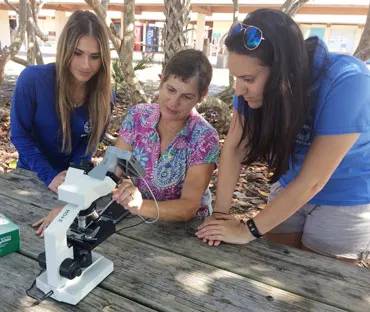As algae blooms increase, scientists seek better ways to predict these toxic tides
Knowing where — and how bad — toxic tides are can help protect health and the environment
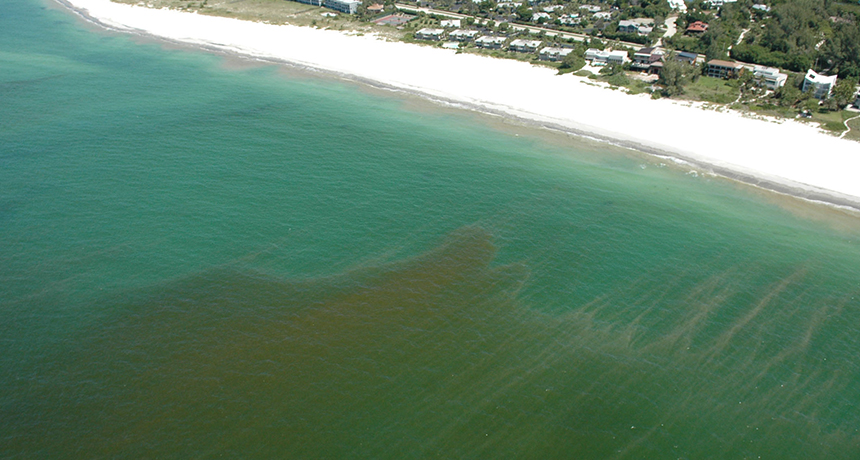
STAINED RED A harmful algae bloom that has plagued Florida’s west coast for 11 months prompted authorities to call a state of emergency on August 13.
Paul Lamison/Tampa Tribune-News Channel 8/Associated Press
The stench of thousands of dead, bloated fish has hung over the beaches of western Florida for months — casualties of an algae bloom that revisits the coastline almost every year. This year’s bloom is particularly intense — and toxic. Called red tides due to the water’s murky reddish tint, the blooms emit a neurotoxin that kills sea creatures, including dolphins and endangered sea turtles, and causes breathing problems for humans.
But the Florida red tide is not the only dangerous algae bloom plaguing water these days. Throughout the United States, a variety of toxic tides are occurring, and they’re happening more frequently, in more places and lasting longer.
On the West Coast, “things have just gotten so much worse” in recent decades, says oceanographer Clarissa Anderson from the Scripps Institution of Oceanography in La Jolla, Calif. Freshwater bodies aren’t immune, either; Lake Erie, for instance, has experienced increasingly large blooms, some even lasting into winter. All of these algae blooms could have negative impacts on human health, animal health and industries like fishing that rely on healthy water ecosystems.
Not all algae are bad. The term “algae” is a catch-all term used for a variety of organisms that photosynthesize and live in watery environments. They include bacteria, single-celled organisms and larger “macroalgae” like kelp.
But the harmful algae blooms, nicknamed HABs, are worrisome enough that scientists are now developing forecasts to better predict when and where they might hit. Many of these forecast systems are still being tested, and most can predict blooms only three to seven days in advance.
The problem is compounded by ongoing runoff from agricultural fields, filling freshwater and marine basins with nutrients that fuel more algal growth. Change associated with global warming, including warmer water temperatures, changes in salinity and higher carbon dioxide levels, could further worsen algal blooms, the U.S. Environmental Protection Agency warns.
Toxic threats
Scientists are working on ways of predicting harmful algae blooms using satellite data, computer analyses and knowledge about the species involved.

Breathing in Florida’s red tides
Scientists are eager to develop ways of predicting when Florida’s algae blooms will create health hazards for people (SN: 8/18/18, p. 19). The tide is caused by fragile, single-celled dinoflagellates called Karenia brevis, which release neurotoxins called brevetoxins when they die or are broken down by tumultuous waves.
During a red tide bloom, the airborne toxins mean that beachgoers “might cough or sneeze or have itchy eyes,” says research scientist Tracy Fanara at Mote Marine Laboratory & Aquarium in Sarasota, Fla. For people already struggling with lung issues, such as asthma or chronic obstructive pulmonary disease, the effects can be worse.
In September 2017, the laboratory began testing a program called HABScope. The lab trained 20 volunteers to sample waters daily at various beaches during a red tide. The citizen scientists place three drops of seawater under a microscope, and record a 30-second video of K. brevis swimming around on the slide. A computer program, developed by the Gulf of Mexico Coastal Ocean Observing System, analyzes each video, using image recognition to count the algae cells in each sample. That information, along with wind and water current conditions, goes into a model created by the National Oceanic and Atmospheric Administration that predicts breathing conditions in the next few days at a particular beach.
The results are published online for the public, telling people if breathing conditions will be low or high risk (intense respiratory irritation, for instance). Across the Gulf of Mexico, a similar program called the Red Tide Rangers is being run by the University of Texas Rio Grande Valley.
While it used to take a scientist an entire day to count the K. brevis cells in one sample, this program “allows a volunteer to do this within five minutes,” Fanara says. “Hopefully with this real-time data that we’re providing, we can get better and more accurate” forecast predictions.
The HABScope program also invites people to submit information about beaches they visit via a crowdsourcing phone app. “Anybody can do it,” Fanara says.
Seafood off the coast of Maine
The Gulf of Maine is home to a nasty algal species that can contaminate shellfish, and if eaten, cause paralysis or even death. Blooms of Alexandrium catenella, single-celled organisms that swim using two whip-shaped flagella, are “incredibly toxic,” says NOAA oceanographer Richard Stumpf, who is based in Silver Spring, Md. Eight people in Maine were sickened with paralytic shellfish poisoning from recreational shellfish harvesting in closed areas from 2007 to 2009.
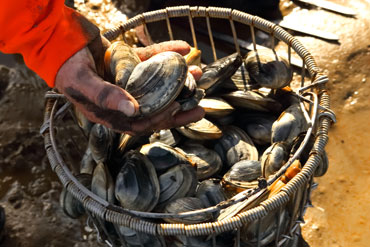
The emergence of a bloom leads fishery managers to temporarily close the region’s multimillion dollar industry for harvesting clams, mussels, oysters, crabs and lobsters. Being able to forecast such blooms would help those managers and area fishermen plan for such closures in advance.
A. catenella flourish in the warmer waters that circulate off Maine’s coast from July through September, consuming available nutrients until they run out. The algae then reproduce, with their offspring clumping together in cysts that sink to the ocean floor until the next warm season. For about 12 years, scientists have been gathering sediment samples from about 50 sites across the ocean floor each October and November and counting the number of cysts in each sample. That information, as well as projections for wind and ocean temperatures, goes into a modeling system for predicting how big the next year’s bloom might be, says Stumpf, who leads the forecasting project.
But that forecast can’t predict exactly which areas will be most affected. For that, the team produces another, shorter-term forecast that relies on data for wind conditions and water temperature, salinity and currents that can estimate local conditions three to seven days in advance.
Neither forecast can tell how toxic a particular bloom might be — a next goal for oceanographer Dennis McGillicuddy at the Woods Hole Oceanographic Institution in Massachusetts. “Shellfish are basically little bio-accumulators of the toxin,” McGillicuddy says. He and his colleagues are working on a model to predict how many toxic algal cells shellfish will be exposed to in a season, and how quickly the shellfish would be able to flush those toxins out — a process that can take months or even years.
The blue-green blooms of Lake Erie
Over the past several years, Lake Erie has been over taken by a thick, slimy foe. Cyanobacteria, also called blue-green algae, “is gross,” Stumpf says. “There’s no other way to describe it.”
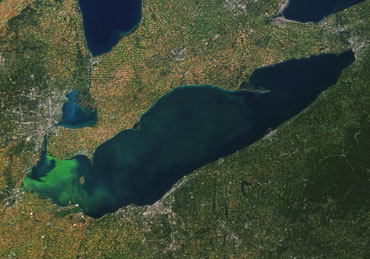
With cyanobacteria found in water bodies across all 50 U.S. states, scientists are working out how to predict blooms so officials can make adequate plans for water treatment. Cyanobacteria produce toxins called microcystins that can cause skin rashes, vomiting and diarrhea in humans.
The biggest cyanobacteria blooms in the United States occur during the warmest months in Erie, the country’s fourth-largest lake and a drinking water source for about 11 million people. Erie’s water is treated, but sometimes not enough if a bloom’s toxicity has been underestimated, leading to illness or temporary water shortages in surrounding areas. In 2014, 110 people were sickened after drinking undertreated municipal water, prompting the city of Toledo to warn 500,000 citizens against drinking tap water for two days.
The intensity of a bloom is directly related to how much phosphorus enters the lake via agricultural runoff (SN: 3/17/18, p. 5). A river monitoring program run by Heidelberg University in Tiffin, Ohio, samples waters flowing into Lake Erie several times a day to measure the phosphorus content entering the lake, Stumpf says, and researchers use this data to predict the seasonal bloom.
Stumpf and other researchers also release a shorter-term forecast — based on satellite images of the bright green blooms along with data on phosphorus content and wind conditions — to show where specifically within the lake a bloom will appear within a few days. Those forecasts then inform online advisories for the public.
Toxic acid in the Pacific
Off the West Coast, from Alaska to southern California, rod-shaped algae called Pseudo-nitzschia proliferate during warm-water months. Some species secrete a toxic acid that can cause short-term memory loss, brain damage or even death in humans if ingested with contaminated shellfish. Restrictions on harvesting Dungeness crab in California in 2015 cost fisheries about $68 million in losses. At least dozens of marine mammals suffering neurological harm are rescued every year.
“This is a really pivotal moment” for developing forecasting models, says the Scripps oceanographer Anderson. She has spent the last decade developing a forecast to predict the algae’s domoic acid levels at locations up to 1,000 kilometers offshore from Oregon and California. The three-day public forecast, called C-HARM, relies on satellite photos that show chlorophyll patterns, ocean temperature and salinity, and three different computer models that integrate these inputs.
Anderson also puts out a monthly bulletin that estimates the probability of a bloom occurring at various locations. Animal rehabilitation centers sometimes use past bulletins to figure out where a sick seal or sea lion may have been poisoned (SN Online: 12/16/15).
Farther up the coast in Washington, the threat of amnesic shellfish poisoning from ingesting domoic acid is particularly concerning for Native Americans, including the Quinault Indian Nation, that traditionally harvest razor clams.
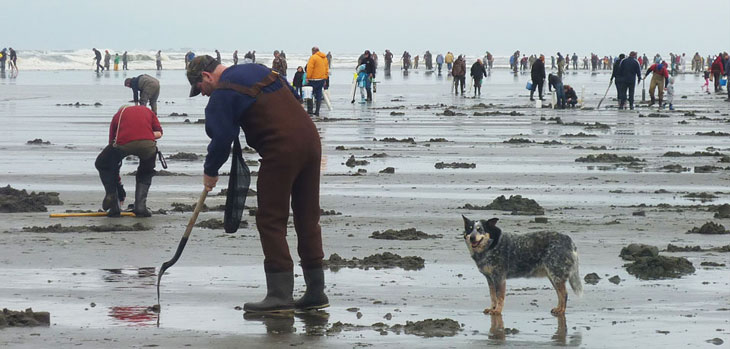
To create a different kind of forecast there, scientists first look at known spots where blooms often begin, so-called initiation sites, and then look to water temperature and salinity conditions to see where the algae might spread. It can take days or even weeks to build a forecast, though, as scientists have to travel by boat to collect samples every other week. But a new, high-tech solution will kick in in September, when the Northwest Fisheries Science Center in Seattle, a branch of NOAA, begins testing an underwater drone that can collect samples more frequently, even in rough sea conditions. “It’s going to improve the accuracy of the forecast,” says center biologist Vera Trainer.
Health and wildlife authorities, as well as tribal representatives, rely on the forecasts to decide which beaches should be closed during clam season. “They’re able to selectively open only those beaches that are safe,” Trainer says. Researchers hope to make the forecast available to the public within a few years.
Editor’s note: This story was updated August 30, 2018, to clarify the HABScope program, and on September 5, 2018, to correct the 2015 Dungeness crab harvest losses and to clarify who receives drinking water from Lake Erie.
